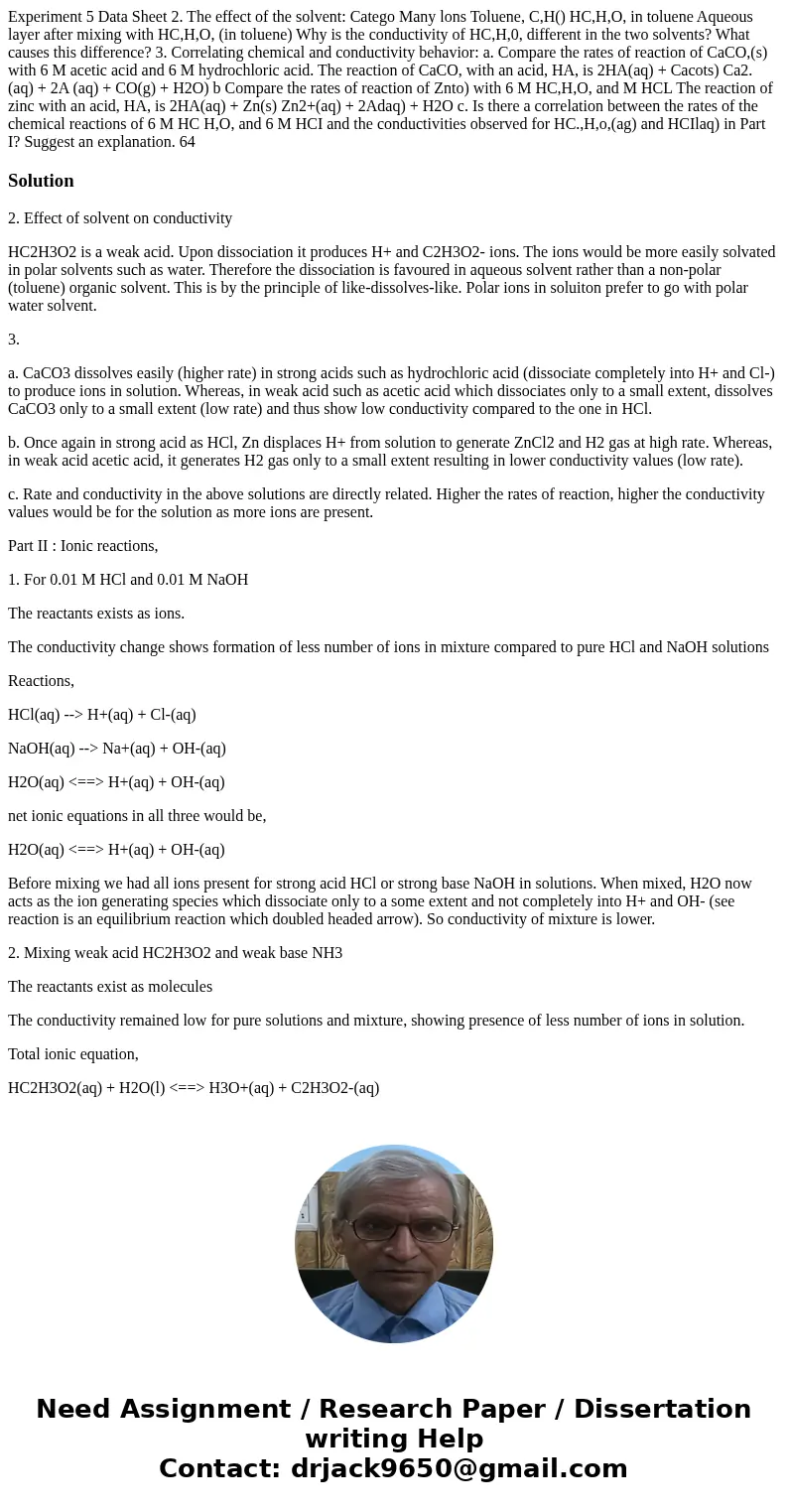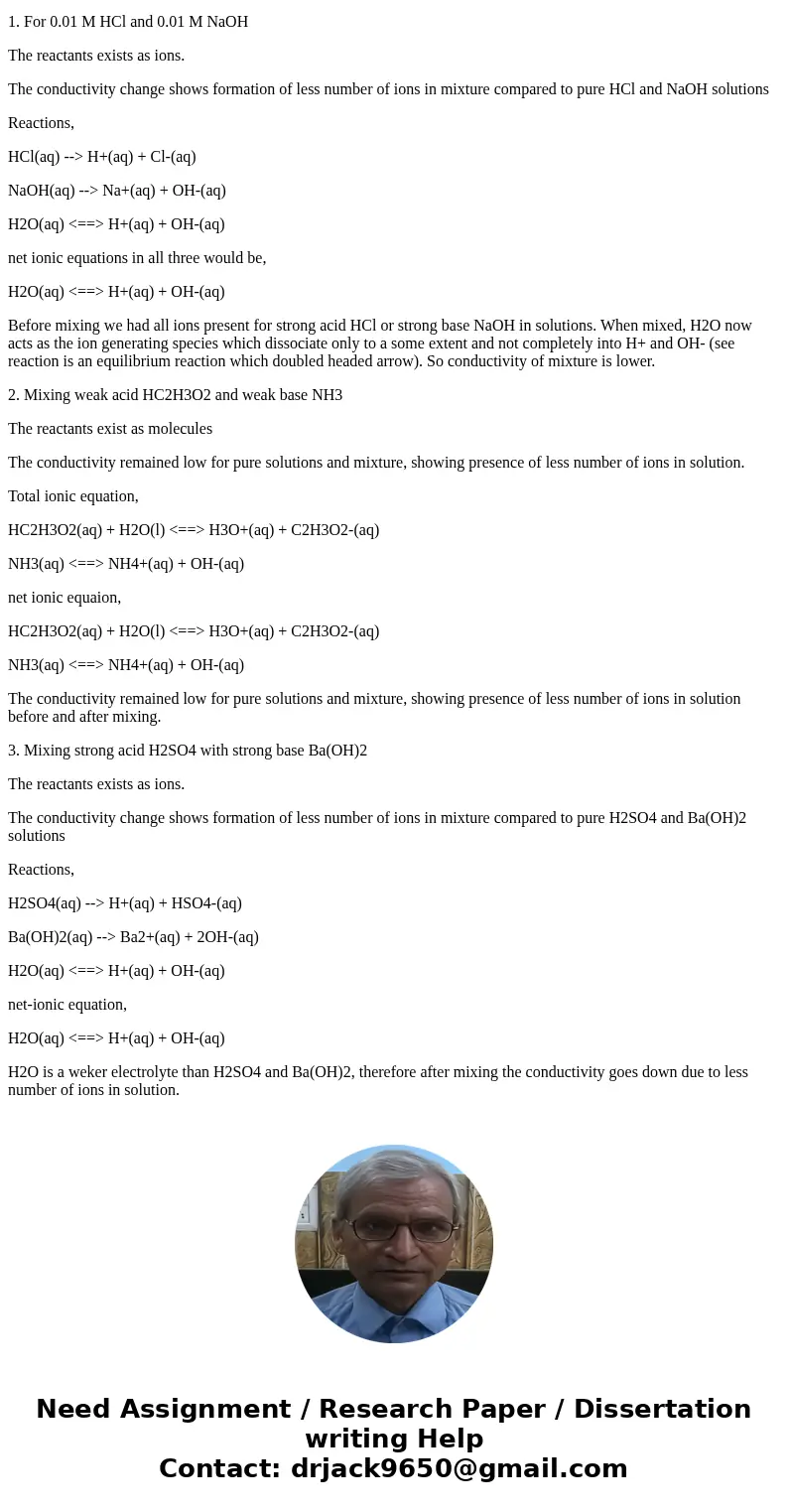Experiment 5 Data Sheet 2 The effect of the solvent Catego M
Solution
2. Effect of solvent on conductivity
HC2H3O2 is a weak acid. Upon dissociation it produces H+ and C2H3O2- ions. The ions would be more easily solvated in polar solvents such as water. Therefore the dissociation is favoured in aqueous solvent rather than a non-polar (toluene) organic solvent. This is by the principle of like-dissolves-like. Polar ions in soluiton prefer to go with polar water solvent.
3.
a. CaCO3 dissolves easily (higher rate) in strong acids such as hydrochloric acid (dissociate completely into H+ and Cl-) to produce ions in solution. Whereas, in weak acid such as acetic acid which dissociates only to a small extent, dissolves CaCO3 only to a small extent (low rate) and thus show low conductivity compared to the one in HCl.
b. Once again in strong acid as HCl, Zn displaces H+ from solution to generate ZnCl2 and H2 gas at high rate. Whereas, in weak acid acetic acid, it generates H2 gas only to a small extent resulting in lower conductivity values (low rate).
c. Rate and conductivity in the above solutions are directly related. Higher the rates of reaction, higher the conductivity values would be for the solution as more ions are present.
Part II : Ionic reactions,
1. For 0.01 M HCl and 0.01 M NaOH
The reactants exists as ions.
The conductivity change shows formation of less number of ions in mixture compared to pure HCl and NaOH solutions
Reactions,
HCl(aq) --> H+(aq) + Cl-(aq)
NaOH(aq) --> Na+(aq) + OH-(aq)
H2O(aq) <==> H+(aq) + OH-(aq)
net ionic equations in all three would be,
H2O(aq) <==> H+(aq) + OH-(aq)
Before mixing we had all ions present for strong acid HCl or strong base NaOH in solutions. When mixed, H2O now acts as the ion generating species which dissociate only to a some extent and not completely into H+ and OH- (see reaction is an equilibrium reaction which doubled headed arrow). So conductivity of mixture is lower.
2. Mixing weak acid HC2H3O2 and weak base NH3
The reactants exist as molecules
The conductivity remained low for pure solutions and mixture, showing presence of less number of ions in solution.
Total ionic equation,
HC2H3O2(aq) + H2O(l) <==> H3O+(aq) + C2H3O2-(aq)
NH3(aq) <==> NH4+(aq) + OH-(aq)
net ionic equaion,
HC2H3O2(aq) + H2O(l) <==> H3O+(aq) + C2H3O2-(aq)
NH3(aq) <==> NH4+(aq) + OH-(aq)
The conductivity remained low for pure solutions and mixture, showing presence of less number of ions in solution before and after mixing.
3. Mixing strong acid H2SO4 with strong base Ba(OH)2
The reactants exists as ions.
The conductivity change shows formation of less number of ions in mixture compared to pure H2SO4 and Ba(OH)2 solutions
Reactions,
H2SO4(aq) --> H+(aq) + HSO4-(aq)
Ba(OH)2(aq) --> Ba2+(aq) + 2OH-(aq)
H2O(aq) <==> H+(aq) + OH-(aq)
net-ionic equation,
H2O(aq) <==> H+(aq) + OH-(aq)
H2O is a weker electrolyte than H2SO4 and Ba(OH)2, therefore after mixing the conductivity goes down due to less number of ions in solution.


 Homework Sourse
Homework Sourse